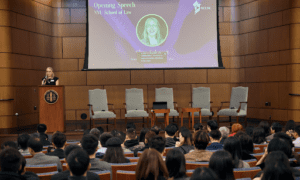In the quiet lanes of Nagpur, a young Manoj Bhoyar once dreamed of chemical equations and lab coats. His father, however, envisioned a different future—one lit by the glow of computer screens. Reluctantly, Bhoyar traded his fascination for chemical reactions for lines of code, setting in motion a journey that would redefine his destiny and leave an indelible mark on the world of artificial intelligence.
The Unlikely Genesis
Bhoyar’s story begins with a compromise. Pressured by his father’s unwavering belief in the digital revolution, he abandoned his childhood ambition of becoming a chemical engineer and enrolled in computer science. The transition was far from seamless. Early programming classes felt alien, and algorithms failed to ignite the spark he’d once felt for science. Yet, driven by filial respect, he persevered, earning an engineering degree that would unknowingly lay the groundwork for his future.
Reflecting on this pivotal decision, Bhoyar shares, “Looking back, I always say to my kids and wife that my father had a vision that was greater than mine. He was aware that computers were the next generation of technology.” Though he initially struggled to reconcile his passion for chemistry with the demands of coding, his career began modestly as a Java developer. A turning point arrived with a project that seemed mundane on the surface: building a linguistic translator to convert English sentences into Marathi. What appeared as a routine coding task became his gateway into artificial intelligence. “For the first time, I wasn’t just writing code—I was teaching a machine to think,” Bhoyar recalls. The project’s intricacies—natural language processing, contextual understanding, and pattern recognition—unlocked a newfound passion. AI was no longer abstract; it was a canvas for human-like problem-solving.
Bridging Code and Consciousness
Bhoyar’s career soon catapulted him into the heart of India’s tech revolution. Roles at Softlink, ICICI Bank, IBM, and Synechron saw him architecting systems for electronic trading, reference data platforms, and secure financial infrastructures. He is experienced of Client Reference Data, Client/Account Onboarding, AML/KYC, Regulatory Program Management and Planning, Service Delivery, Business Analysis and Transformation, and Technology Solution Architecture.
Yet, it was his parallel role as an educator that shaped his unique perspective. Teaching programming to students and professionals, he distilled complex concepts into digestible lessons, a skill that later defined his approach to demystifying AI. “True mastery lies in simplicity,” he often says. This duality—coder and teacher—fueled his ascent.
The Scholar’s Creed
Beyond corporate triumphs, Bhoyar’s academic rigor cemented his reputation. His research, published in esteemed journals, tackled frontier challenges: deploying AI-powered edge computing to reduce latency in IoT devices, designing federated learning systems for privacy-preserving anti-money laundering collaborations, and automating anomaly detection in sprawling datasets. Each paper reflected a dual commitment—to push technological boundaries while anchoring solutions in real-world impact.
In 2024, this ethos earned him the Global Recognition Award, celebrating his contributions to modernizing fintech. “This award isn’t just mine,” he humbly remarks. “It’s a testament to every team that transformed lines of code into tools of progress.”
A Blueprint for the Future
Despite AI’s meteoric rise, Bhoyar noticed a paradox: organizations recognized its potential but faltered in execution. Legacy systems, ethical dilemmas, and a chasm between theory and practice stifled progress. His response was Deep AI Integration: Theory and Practice of Machine Learning in Complex Systems—a manifesto born of decades of trial, error, and revelation.
The book distills AI’s complexities into actionable wisdom. Through practical case studies, Bhoyar illustrates how innovation need not demand upheaval. For instance, his exploration of optimizing database replication strategies in cloud environments demonstrates how machine learning can enhance system reliability without overhauling existing infrastructure.
Yet, the book’s soul lies in its ethical imperative. Bhoyar confronts AI’s darker echoes—algorithmic bias, privacy erosion, and the myth of neutral machines. “Bias in AI isn’t a glitch; it’s a reflection of our own blind spots,” he warns. His framework for ethical integration mandates transparency, diverse training data, and continuous human oversight.
Visionary at Heart
Today, Bhoyar’s gaze extends beyond boardrooms and data centers. He envisions AI as a democratizing force: predictive healthcare models reaching rural clinics, IoT sensors empowering smallholder farmers, and adaptive learning platforms bridging educational divides. “The true measure of AI isn’t in Silicon Valley labs,” he asserts. “It’s whether a farmer in Vidarbha benefits as profoundly as a trader on Wall Street.”
His advice to aspiring innovators is characteristically grounded: Start small. Embrace curiosity. Never confuse speed with progress. “Pilot projects are laboratories for wisdom,” he advises. “And ethics isn’t a checkbox—it’s the foundation.”
Epilogue: The Human Algorithm
Manoj Bhoyar’s journey—from a reluctant student in Nagpur to a global AI visionary—is more than a chronicle of technical prowess. It’s a testament to the power of adaptability, the courage to question, and the audacity to reimagine the familiar. His legacy lies not in algorithms alone but in a philosophy: that technology, when guided by empathy and ethics, can be humanity’s most faithful ally.
In an interview following his Global Recognition Award, Bhoyar elaborated on his vision: “AI has the potential to revolutionize industries by enabling informed decision-making, automating tasks, and uncovering inaccessible insights. But we must approach its development with ethical considerations, ensuring it serves the greater good.” When asked about integrating AI into legacy systems, he emphasized starting with clear goals: “Identify the problems you want to solve. Pilot projects offer insights that pave the way for larger implementations.”
As industries race to harness AI’s potential, Bhoyar’s story serves as a compass. His book, research, and teachings continue to inspire a generation of innovators to bridge the gap between ambition and execution, reminding us that the future of technology is not just coded—it’s consciously crafted.





























